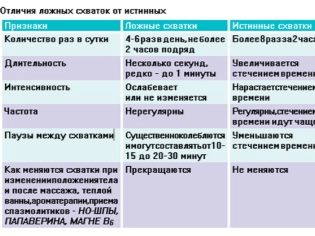Intervals between contractions and their duration
Contractions - the first stage of labor began. Their main task - the disclosure of the cervix. In order for a child to leave the uterus, her neck must open completely. The uterus can be compared with a muscular pouch that is tied. If the knot is untied, it will be possible to get the contents out of the bag. The process of opening the neck - this is the process of "unleashing".
Real fights - what are they?
Pregnant women are usually actively interested in the nuances of their condition, and there is plenty of information today. Therefore, future mothers are well aware of the fact that contractions between contractions are different.
There are training contractions of the uterus, which never under any circumstances contribute to the disclosure of the cervix. There are preparatory fights, precursors. They are associated with active physiological preparation of the body for childbirth, smoothing of the cervix, its softening. Such abbreviations also do not lead to the opening of the uterus, but symbolize the start of the preparatory stage.
Real contractions begin after the woman's body is fully ready for childbirth. This long, painstaking, detailed preparation. It begins almost from the very first day of pregnancy and ends when the baby is ready to be born. Preparation goes on different levels: the hormonal background of a pregnant woman should change before the birth - estrogens, relaxin, prolactin, and oxytocin replace the head of progesterone. When the concentration of oxytocin reaches the required level, the uterus begins to contract.
During preparation for childbirth in the uterine tissue, a new intracellular process starts: the protein actomyosin is produced. Thanks to him, the cells (myocytes) that make up the uterine tissue will be able to shrink and stretch. When all the internal conditions for the onset of labor activity are met, the very real labor contractions begin, which expectant mothers expect with such excitement in the late stages of pregnancy.
Each contraction gradually leads to the opening of the neck. The neck is a tight round muscle, which is very difficult to open. That is why the labor period of labor from the first uterine contraction to the complete opening of the cervix is the longest.
The real contractions differ from all other cuts that a woman encountered while carrying a baby. They are characterized by frequency, regularity and irreversibility. If they started, it will not be possible to stop or weaken the cuts - nature itself begins to “lead” the process. Regular contractions tend to progress: the contraction of the uterus becomes longer, the time of uterine tension increases, and the interval between contractions of contractions becomes ever shorter. It is for this feature that generic contractions differ from all other types of contractions — women need to pay close attention to these intervals.
As the intensity of contractions increases, so does the opening. The strongest contractions are usually observed before the attempts, that is, immediately before the full disclosure and expulsion of the baby from the cozy mother's womb.
During each spasm, the woman feels the tension of the uterus muscles.This sensation usually begins with the lumbar region, then smoothly, like a wave, covers the sacrum, lower abdomen and extends to the entire abdominal wall. The moment of the beginning of tension is the beginning of the struggle. The time elapsed from the beginning of the contraction to the relaxation of the uterus is the duration of the spasm. The time of relaxation and rest from the end of the fight to the beginning of a new one is an interval.
Knowing this, a woman can easily calculate the duration of her contractions, understand at what stage she is, and how long before the birth of the baby.
Periods
It is very difficult to confuse these uterine contractions with other sensations that a pregnant woman experiences in abundance at a late term. Uterine contractions that lead to cervical dilatation, that is, true contractions, cannot be subordinated to your will, cannot be stopped by taking a pill of an antispasmodic drug or standing in a warm shower - everything that helped reduce uterine stresses during training fights no longer works. Contractions develop by their own laws. The entire labor period of labor is called the first stage. It consists of three successive stages, which will be discussed below.
Latent
The term "latent" means hidden. This period begins with the first fight and lasts quite a long time. It is during this period that a woman is tormented by doubts, whether childbirth has begun or not yet, what is happening and how to calculate reductions, it's time to go to the maternity hospital or it is too early. This period is usually not associated with severe pain.
Spasms in the latent period are repeated relatively rarely - uterus tension occurs every 30-40 minutes, each contraction lasts no more than 20 seconds. A small error of 4-5 minutes is quite acceptable.
If such contractions have begun, then there is no need to panic; it’s too early to run with the bag at the ready. The period lasts more than 8 hours, and even longer, and there is plenty of time to quietly drink tea, eat a small piece of chocolate, stock up on energy, check whether everything is collected from what needs to be taken to the obstetric institution.
The latent period, despite its long duration, does not lead to the rapid opening of the cervix. By the end of the period, it opens only up to 3 cm, which is about a third of the disclosure required for the birth of a baby. The level of oxytocin in the mother is gradually increased, contractions gradually become more frequent. By the end of the latent period, the duration of the contraction is on average about 30 seconds, the interval between them is at least 5-7 minutes.
Active
The next stage of labor is called active. Active spasms are more frequent, most palpable. Pain can be more pronounced than in the previous phase. The main stage of cervical dilatation begins: it has to open to about 7 cm. Each contraction in this period lasts 40-50 seconds, the interval between uterine stresses is 4-6 minutes.
Neck opening is faster. Now it is about an centimeter per hour. This period is quite difficult for women, because it is long and painful. On average, active contractions last 3-5 hours.
Transition
This stage is the shortest of the three. Spasms intense, frequent. Each of them lasts about 60-70 seconds. Rest periods are minimal: about 1-2 minutes. A woman in this period is very difficult, but in 1-1.5 hours the cervix has time to fully open up to 10-12 cm (depending on the size of the pelvis of the woman).
Transitional fights, therefore, are called transitional ones, which, when fully disclosed, turn into attempts. There is a feeling of heaviness, the desire to go immediately to empty the intestines. Baby uterine contractions begins to "push" into the genital tract.
When such sensations appear, the medical personnel should be immediately informed about this - the attempts should proceed under the control of the obstetrician so that the child and the woman are not injured.
Features at birth
First birth
If a woman is going to give birth to a firstborn, then the bouts will be longer. The cervical dilatation is slower, so all periods of labor activity take longer, except for the birth of the placenta - it usually appears in such women before the multiparous.
Pain in the first birth is usually more intense than in multiparous ones. All successive stages of contractions during the first birth can take from 10 to 20 hours.
Repeated delivery
In the second, third and next genera, the woman's body more willingly responds to the demands of nature, therefore the cramps last less, and the pain, according to the women, is transferred much easier. The cervix and the reproductive organ itself are somewhat stretched compared with primiparous, less fear, and the woman is able to relax between contractions.
Often the latent period of contractions for multiparous remains almost unnoticed. Women describe how they felt aching in the lower back, a little pulled stomach, but with contractions it was not identified. As a result, a woman comes to the hospital already when the baby is almost ready to be born.
All periods of multiparous lasts much shorter: hidden usually does not exceed 6-7 hours, active - about 3 hours, transitional fights can last about half an hour. On average, women give birth to a second or third baby in 8-12 hours.
When you need to come to the hospital?
When contractions are repeated every 15–20 minutes, go to the obstetric institution early. With such a contractile frequency to the active phase, which ideally should take place under medical supervision, there is still a lot of time.
Knowing that active contractions start when the neck is opened at 3-4 cm, and this process takes about 6-8 hours during the second birth and much longer at the first, it will be easy for a woman to determine the optimal time to come to the hospital. Doctors advise to do this when the latent period ends. The contractions are repeated every 5 minutes for 1 minute or slightly less.
In order not to lose, it is best to call an ambulance when the contractions are repeated every 6-10 minutes. In giving birth for the second or third time there is less time, so you need to hurry and call an “ambulance” in advance with the frequency of uterine contractions every 10-15 minutes.
Do not wait for the right moment and do not consider uterine contractions, but go straight to the hospital in the following cases:
- if amniotic fluid is poured;
- blood discharge from the genitals;
- contractions began until the moment when the pessary was removed from the woman;
- in all cases when the condition of the woman in labor has become much worse: pressure is jumping, there is dizziness, vomiting, loss of consciousness.
Before the maternity hospital there is nothing to eat except a small piece of chocolate. If you really want to eat or drink, then you need to drink a small amount of liquid, and tablets and other medicines should be avoided.
How to count?
You can take it as it did before: by the clock or stopwatch. If a woman suspects that she started having regular contractions, it is worth noting the beginning of each contraction, indicating the time, the beginning of the relaxation, as well as the time until the next contraction.
You need to try to accurately measure the seconds - they will help you to understand whether real contractions or training started. To ease the task of the woman in labor can counters contractions - these are special applications for smartphones running on different operating systems.
A woman needs to mark the beginning of a fight by pressing a button, and then follow the program instructions. The application will not only determine the duration of the fight with high accuracy to tenths of a second, but also analyze the pattern. As a result, the program will signal that it is time for a woman to assemble at the maternity hospital.
It is difficult to say how accurate such programs are.The organisms of women are individual, and the program works according to averaged set parameters, so it may not identify abnormal contractions when labor activity develops with pathology.
Possible problems
Contractions may be abnormal for various reasons. The most common - the weakness of labor. Contractions may be weaker or ending. Neck opening is too slow. Weak labor contractions may well be combined with discoordination of labor, while uterine contractions are often frequent, but short, repeated after 30 seconds, a minute, but not exceeding 20-30 seconds in duration.
The timer in the smartphone on such situations often does not respond. The frequency of contractions should be checked with the help of a normal clock with a second hand or an electronic stopwatch.
Weakness of labor is called primary generic weakness. She always has to have a source, a reason, but it is not always possible to find it in practice. Very often, primary weakness leads to emergency surgery.
Most often the prerequisites for such a pathology are reduced muscle tone of the uterus due to hypoplasia, endometritis, tumors, several abortions in history, hormonal imbalance.
Complications are not excluded in women with preeclampsia and obesity, bearing a large fetus, in nulliparous. There is also a pattern between fear and the discoordination of contractions: the more a woman is afraid, the higher the likelihood that contractions will weaken and their periodicity will break.
How to make cuts less painful?
In addition to counting contractions and spacing, a woman must observe proper breathing, which she was taught in courses for pregnant women. To facilitate the fight help certain poses. In the hospital can also be used painkillers.
For information on how to recognize false and real contractions, see the following video.


























